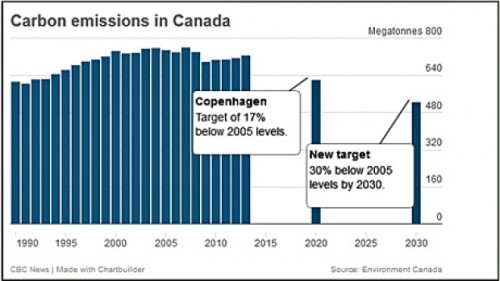May 16, 2015 – The commitment is finally made. Canada pledges to reduce GHG emissions by 30% below 2005 levels by 2030. The federal government’s spokesperson, Leona Aglukkaq, Environment Minister, announced this target based on what she has received from provincial and territorial governments.
Canada’s federal government recently claimed it couldn’t commit to action until it had heard from the provinces. Ontario’s commitment to 37% reduction of GHG emissions from 1990 levels by 2030, as Canada’s largest province, certainly paves the way for Aglukkaq’s far less ambitious goal. Why less than what Ontario has pledged? Because the federal government refuses to establish specific emission reduction targets for its favorite industry, the oil sands, the fastest growing source of emissions in the country. The Prime Minister has stated repeatedly that tough emission standards on the oil sands would be “crazy” in a period of low oil prices.
What is also unusual about this announcement is the break with the government’s previously stated policy to be in lockstep with the United States in environmental commitments. The federal government has repeatedly held off making pledges on environmental issues citing the lack of any firm commitment by the United States. But earlier this year President Obama pledged to GHG reductions of 28% by 2025 from 2005 levels. Canada’s commitment will only achieve a 23.5% reduction in the same time frame.
In one area Canada remains faithful to its lockstep approach with the Americans – the regulation of methane emissions from fracking operations. Fracking here does not play a significant role in our extractive capacity and a number of provinces have banned it or put a moratorium on the practice, whereas in the United States fracking is one reason for that country’s dramatic rise in oil production of late.
As for Ontario, its commitment comes following the province’s agreement to join a cap and trade program with Quebec and California. In 2014 Ontario closed its last coal-fired power plant. The province is taking a trans-national leadership role by hosting a climate summit in July of this year as part of the PanAm/ParaPan Games in Toronto. The nations participating in the Games will all be represented and the goal is to establish common climate action commitments prior to the upcoming Paris conference in December 2015.
Other provinces have made commitments. British Columbia’s emission target is 33% below 2007 levels by 2020. That province has a successful carbon tax and has also joined a cap and trade initiative with several American states.
Alberta, where the bulk of oil sands production lies has committed to reduced emission intensity and put a $15 carbon tax on emitters who exceed established threshold limits.
Quebec has set an emission target of 20% below 1990 levels by 2020 and is in a cap and trade agreement with California and Ontario.
Saskatchewan’s emission target is 20% below 2006 levels by 2020. Saskatchewan which gets most of its energy from coal-fired power plants has put its eggs in the carbon capture and storage (CCS) business with the first commercial operational facility in the country.
Nova Scotia, New Brunswick and Newfoundland and Labrador have in past pledged to reduce emissions by 10% below 1990 levels by 2020. Nova Scotia relies on coal-fired power for much of its energy. New Brunswick is Canada’s third highest GHG emitter because the Irving oil refinery is located there. Newfoundland and Labrador produces hydroelectricity and oil mostly for export. New offshore oil production will make it difficult for that province to meet a lid on GHG emission growth.
As for Prince Edward Island and Manitoba, it is unclear what kind of GHG reduction commitment these two provinces are prepared to make. The deadline to set GHG emission reductions is June 1st.
The territories, which include Yukon, Northwest Territories and Iqaluit, all recognize that they are small contributors to the total amount of GHG emissions in the country, but at the same time they will be the first to be impacted by global warming as the permafrost and Arctic Ocean sea ice melts. All have embraced emission reduction strategies but are counting on the provinces and the rest of the world to make good on their pledges to help keep warming to no more than 2 Celsius (3.6 Fahrenheit) degrees globally. For the Arctic that may translate to temperature increases between 5 and 9 Celsius (9 and 14 Fahrenheit).
Aglukkaq may have an unforeseen ally in making her national GHG reduction pledge. Although the feds have put no emission constraints on the oil sands sector, lower global oil prices may just do what the government won’t – create constraints. In the past few months oil sands expansion projects are on hold or shelved indefinitely because at $50 to $60 a barrel on world markets producing bitumen is very unprofitable. The consequence a potential halt to increased emissions from the oil sands for the foreseeable future.















